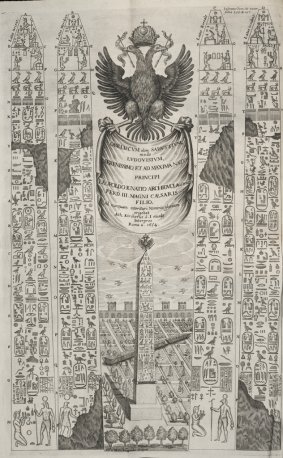Obelisci Aegyptiaci
Egyptosophy
Obelisci Aegyptiaci [ edit ]
Kircher was a prolific but academically uneven Jesuit scholar whose work combines an astonishing blend of fact, fantasy, and chicanery. He was a polymath who studied phenomena as disparate as the subterranean world, music, and the magic lantern (an early image projector). Kircher was the publisher of the first Coptic grammar and dictionary widely available in the Western world, and a self-professed "translator" of Egyptian hieroglyphs. His writings blend neo-Egyptosophical activities with genuine early Egyptological work. He correctly proposed that the Coptic language--the study of which he placed on a modern linguistic footing--represented essentially the spoken language of pharaonic Egypt. Kircher incorrectly believed that hieroglyphs were symbolic, writing a "Hermetic" vocabulary of divine knowledge. See the section "Hieroglyphs" for how the phonetic values of ancient Egyptian signs actually functioned.
The two books displayed here, Sphinx Mystagoga (The Initiating Sphinx) and Obelisci Aegyptiaci (Egyptian Obelisks), demonstrate Kircher's attempts to copy and translate hieroglyphic inscriptions. Kircher translates the text to the left as: "After Typhon (Seth) has been conquered, the matter of life will be preserved through the moistness of nature during the vigil for Osiris. Through the aid of sacrifices conducted under the leadership of Anubis (Mercury), life and virtue will be increased within the Nilotic vases." The actual translation is "Words spoken by the Osiris, Djedher (the name of the deceased)." While we now read the hieroglyphs as a mixture of phonetic and ideographic signs, Kircher's translation was based on purely symbolic readings of each hieroglyph, assuming that each text revealed hidden knowledge about the cosmos.
Dimensions
H. 36.6 cm, W. 26.6 cm
Artist or Author
Athanasius Kircher
Museum
Beinecke Rare Book Library
Accession Number
Fke30 +K632

































